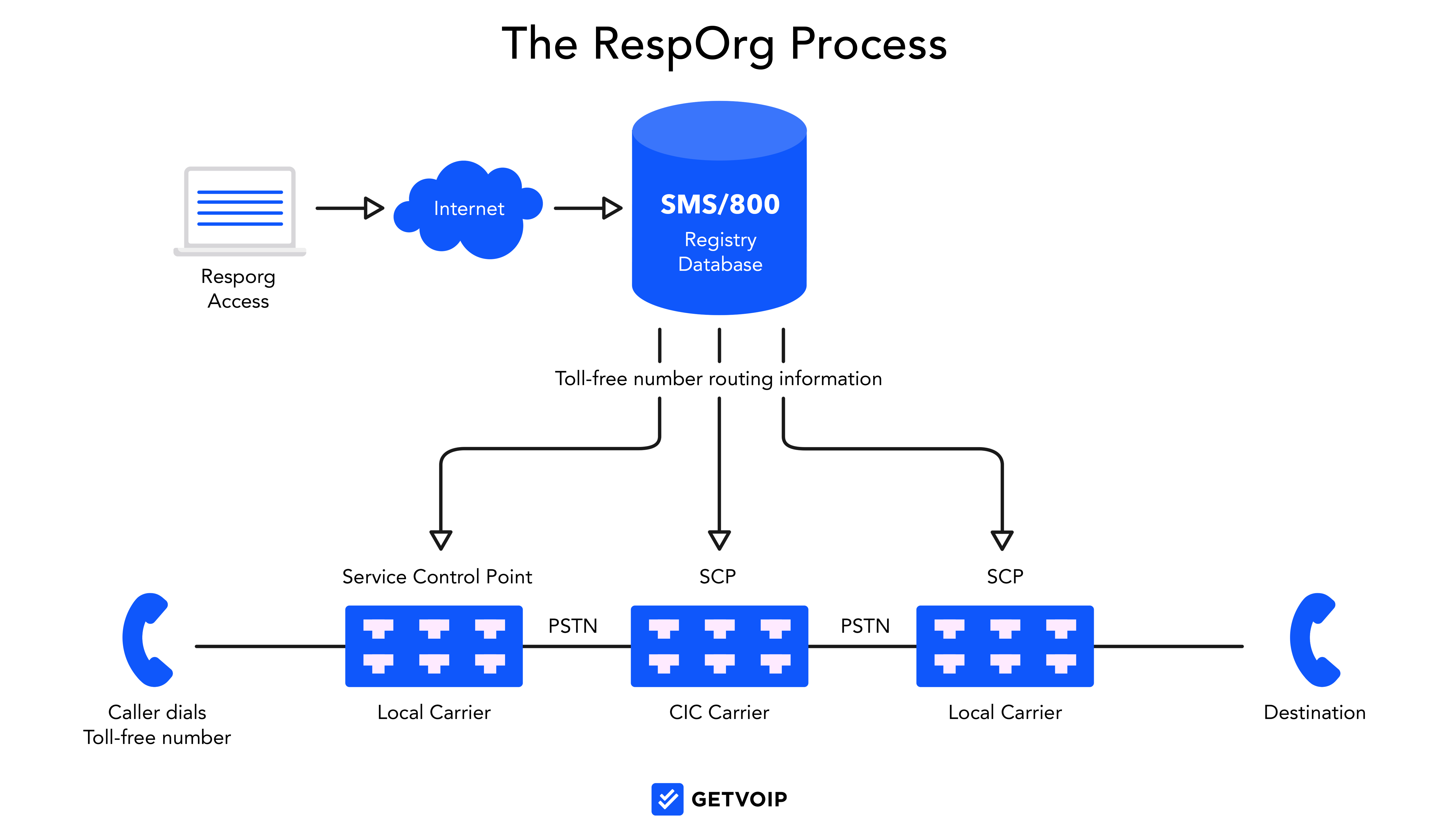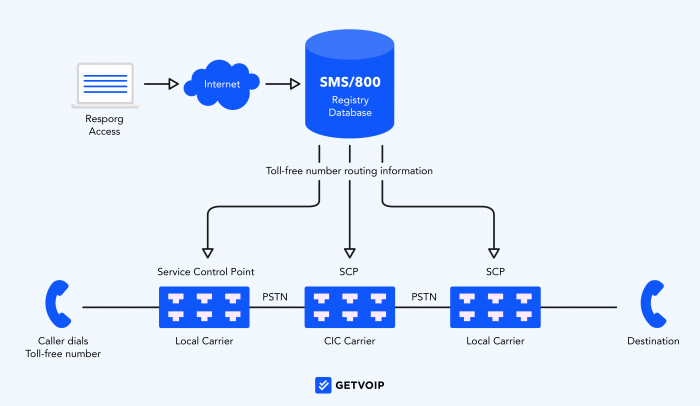Toll-free phone numbers allow callers to contact your business at no charge to themselves, encouraging new leads and customers to contact your company.
RespOrgs are responsible for registering, indexing, and managing toll-free numbers.
This article will overview RespOrgs, including how they work, how they route toll-free calls, how to find a RespOrg, how to become a RespOrg, how to change RespOrgs, and if using one is right for your company.
- What is a RespOrg?
- How Does it Work?
- The RespOrg Process
- How to Find a RespOrg?
- Become a RespOrg
- Change a RespOrg
What is RespOrg?
RespOrg, short for Responsible Organization, refers to phone carriers that own, manage the registration, and provide routing directions for toll-free numbers. A RespOrg is any company that sells toll-free numbers, indexes them in the 800 database, or ports them between telecom carriers.
RespOrgs are accredited by Somos, Inc., a certification that enables service providers to sell, route, and manage toll-free numbers in the FCC-authorized SMS/800 TFN Registry database. Not only landline phone system providers like AT&T, but cell-service providers like Verizon and most VoIP providers–like RingCentral, Nextiva, and Dialpad–are RespOrgs.
Since RespOrgs are also service providers, they provide routing directions for their customers’ toll-free calls across a web of registered public-switched telephone network (PSTN) carriers. RespOrg routing plans include backup directions and carriers, in case of an outage or if the customer wants to split inbound traffic among multiple carriers.
How Does RespOrg Work?
RespOrg service providers reserve toll-free numbers directly from the 800 TFN Registry, sell them to businesses, and index each number’s assignment and activity status in the database. RespOrg service providers also use the database to maintain each number’s global routing information–which tells carriers where to route a number’s calls and SMS texts.
Toll-free numbers are distinct 3-digit codes (800, 888,877, etc) that allow customers to call and text a business for free–using the PSTN from anywhere in the world–charging the business the full cost. While many phone and VoIP providers sell local phone numbers, vanity numbers, and toll-free numbers, each type of phone number is registered, indexed, and managed in a distinct database. In the SMS/800 TFN Registry, each carrier has a unique Carrier Identification Code (CIC), which connects them to the web of toll-free carriers in the database and provides routing directions for their registered toll-free numbers.
Every toll-free number is listed in the Registry under its current carrier’s CIC, along with its routing information–the network of PSTN carriers and backup options where service providers should route its inbound data and signal.
Each CIC carrier approves all Registry numbers associated with it, validating their routing instructions for other service providers to follow. Therefore, it’s important for RespOrgs to keep each toll-free number’s status, registration, and routing preferences up to date–so that service providers know where to route a number’s toll-free data.
RespOrg service providers–VoIP, mobile, or PSTN carriers–often utilize a combination of CICs to offer their customers advanced routing options, such as business hour or weekday schedules, geographic customization, call percentage delineation, and no-ring forwarding.
What is the RespOrg Process?
Here is the routing process when a customer dials a toll-free number:
- A caller dials a toll-free 800 number
- The caller’s service provider receives the caller’s and toll-free number’s information
- The service provider accesses the TFN Registry via a service control point (SCP), dispersed throughout the US
- The SCP provides the toll-free number’s CIC with routing directions, which the RespOrg has kept up-to-date
- The service provider then routes the call to the CIC, which routes it through the PSTN to the destination

How to Find a RespOrg?
Any service provider who sells a toll-free number is a RespOrg, so most phone service providers–including landline, cellular, and VoIP providers–are RespOrgs. Somos, Inc. administers the TFN Registry and provides RespOrg accreditation.
Find a list of accredited RespOrgs at the Somos website: www.somos.com/find-a-toll-free-number.
Since most phone service providers are accredited RespOrgs, you can also contact your telephone company directly to ask if they offer RespOrg toll-free services.
Popular RespOrg VoIP providers include:
- RingCentral
- Nextiva
- Dialpad
- Zoom Voice
- Vonage
- Grasshopper
- Phone.com
How to Become a RespOrg?
Any company that sells or uses toll-free numbers–including telecom companies, application vendors, and phone service providers–can become an independent RespOrg and get certified as a Toll-Free Service Provider.
The Somos Toll-Free Service Provider application process includes three steps:
- Submit an online application: Submit a service management system application, accessible here. The application includes 7 pages and gathers basic information about your company.
- Pass a certification exam: One of your organization’s employees is required to pass the exam. You can self-train with Somos-provided materials or attend a 5-day TFN Registry preparatory class.
- Pay a $4000 deposit to Somos, Inc.
Advantages of RespOrg Certification
RespOrg certification provides access to the SMS/800 TFN Registry, along with the ability to instantly reserve toll-free numbers, sell them, and manage routing plans for your own and your customers’ toll-free numbers. RespOrgs gain more control over how global calls route through the PSTN to their own toll-free numbers. As your own RespOrg, you can utilize global carriers in routing plans for your toll-free numbers, potentially saving money when contacted by customers making international calls.
Drawbacks of RespOrg Certification
However, RespOrg certification also includes a few downsides and risks: RespOrgs shoulder the additional responsibility of managing toll-free telephone numbers within the TFN database, which takes time and attention. In most cases, RespOrgs only have one employee who has trained and passed the exam; if this employee leaves the company, the RespOrg must train another employee to pass.
How to Change a RespOrg?
A company can transfer its toll-free numbers from one RespOrg to another via a process called number porting. This is especially common when an organization switches phone systems or telecommunications providers but wants to keep the same business phone numbers. All RespOrgs are able to facilitate porting, and the process typically takes between 5 business days and multiple weeks.
In order to port a toll-free number, the business using the number must contact their old and new RespOrgs to authorize, release the number, and facilitate the registration transfer.
Use the following process to port your toll-free number to a new RespOrg:
- Identify your new provider: Select a business phone system with the features, channels, and pricing that best fit your company’s needs
- Contact your new provider to ensure RespOrg certification: Inform your new carrier that you’d like to port a toll-free number and use them as a RespOrg. They may request a formal letter of authorization. Many providers’ websites have built-in verification search bars where you can check if they support transfers for your numbers.
- Contact your old provider: Before canceling, reach out to your old RespOrg to inform them about your transfer, and request that they release your toll-free numbers. Complete any requested forms or steps.
- Wait until the transfer is confirmed: Once the toll-free number porting is confirmed with your new provider, contact your old RespOrg to cancel any subscriptions or licenses
In most cases, your company will not need to become a RespOrg yourself. However, if you want to use a toll-free number, you will need to work with a RespOrg.
Toll-free business phone numbers attract leads and customers globally by sparing customers the cost associated with calling the number. While this means that your company incurs more expenses, the benefits of more inbound calls typically outweigh the negatives.



